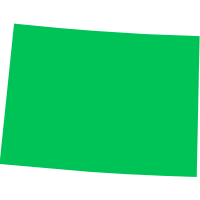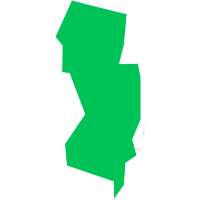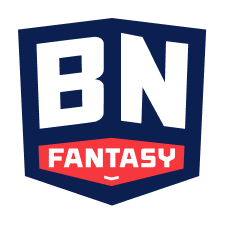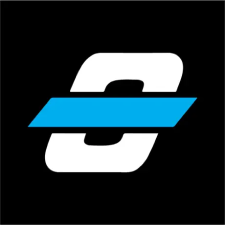NASCAR is in Sin City this weekend for 400 miles of racing at Las Vegas Motor Speedway (LVMS). Oddly enough, qualifying was washed out in one of the driest parts of the country, which means the field will be set by last year's owner's points. As a result, Kyle Busch will lead the field to the green flag for 267 laps of racing at the 1.5-mile oval.
This is the second year of the current aerodynamic package. Nine races were run at 1.5-mile tracks excluding Homestead, which is grouped in the steep track category, and Atlanta, which used a slightly different aero package. I'll rely on those nine races, but also adjust for track specifics as well as practice results to help you optimize your DFS lineups this weekend.
Lineup Construction Strategy
Like last weekend for Daytona, I will use DraftKings scoring for the basis of my strategic advice. On FanDuel, you can weight place differential less, and finishing position more.
Last year at Las Vegas, the starting position of the two winning lineups were as follows:
- Spring: 10, 20, 23, 25, 28, 38
- Fall: 8, 22, 23, 24, 27, 33
That's one driver starting inside the top 10, and the rest starting 20th or worse. Do I expect the same trend to continue this weekend? Not necessarily, especially with a qualifying washout. But that should give us an idea that place differential is going to be important.
Because there are only 267 laps, and Las Vegas is a place where we get only one or two drivers to dominate a race — in other words, lead a large chunk of laps while also picking up many fast laps — you can plan around that when building your lineups. For each lineup you create, start by picking just one or two expensive drivers who you expect can dominate the race, then fill the rest of your lineup by optimizing the combination of place differential and finishing position while remaining under the salary cap.
So who do I like to dominate? Let's dive in.
Dominators
Here are a few drivers I like as potential dominators, with my cash game and GPP preference listed at the end.
1. Kyle Busch ($12,400)
The reining series champion gets the pole position by virtue of the qualifying washout. The Toyota camp (other than Daniel Suarez) missed the first 15 minutes of the opening practice session for "us[ing] Bondo to change the shape of the front fender." Then in practice the Toyotas were slow, with no driver placing inside the top-10 over five, 10, 15, and 20 consecutive laps in final practice.
Only Martin Truex Jr. (10th) did so in first practice over five consecutive laps. Practice and racing are different. Will his starting position and immense skill keep Busch out front enough to make it into the winning lineup at $12,400?
2. Kevin Harvick ($12,000)
Harvick is the top starting non-Toyota driver, taking off from the third position and posted the fastest 10-lap average in final practice. He also led 88 and 47 laps, respectively, in the two Vegas races last year, finishing in the-top four in each race. However, he was not included in the winning lineup on either occasion. That's partly because of his high price tag, but also because he wasn't a clear top dominator.
Harvick had stiff competition in the dominator category from a cheaper driver in both races…
3. Joey Logano ($10,700)
…and that driver was Joey Logano.
Logano led 86 and 105 laps in the two races at LVMS last year while picking up an average of 11 place differential positions. That put him in the optimal lineup on both occasions. Logano rolls of from the fifth position as the top finisher outside of last year's Championship Four. He's also the 2018 Cup Series champion.
Logano was fastest over five laps in opening practice, but wasn't as fast in final practice. He placed 12th, 20th, and 14th over five, ten, and 15 laps in final practice.
4. A Chevy Surprise?
No Chevy driver led more than 8.6% of the total laps in either Vegas race last year. But the Bow-Tie contingent looked strong in practice with Alex Bowman, Kurt Busch, Kyle Larson, and William Byron all consistently strong between five and 20 consecutive laps.
Another Chevy, seven time series champion Jimmie Johnson, was quickest over five laps and second-fastest over 10 laps, which may draw a lot of attention. But I should note his drop-off in speed between five and 10 laps was concerning.
Let's compare him to his Chevy colleagues:
Notice Johnson was two-tenths of a lap slower over 10 laps than five, while Kyle Larson barely lost any time as the run went on. Calculating it out, Johnson was actually the slowest of the five listed above from laps six to 10, and there will be green flag runs far longer than 10 laps.
The Picks:
For cash games I think place differential will help out here, so for dominators I'm willing to take it a bit easier and play the driver that's the cheapest of the non-Chevy drivers I listed above. This driver also dominated both Vegas races last year.
That means I'd plug in Logano as my option, saving $1,700 and $1,300 of cap space respectively compared to Busch and Harvick.
For top-heavy structures, I really like playing Kyle Larson as my surprise dominator. He not only had the smallest drop-off from five to 10 laps among the Chevy drivers, but he also had the smallest drop-off in time from five to 25 laps. In fact, his time loss over this duration was smaller than any other driver's time loss from five to 20 laps, and notably, it was smaller than Johnson's drop from just five to 10 laps!
Johnson should garner a higher ownership percentage for the raw five- and 10-lap times, but it's Larson we should be playing in tournaments. He has the raw upside and the hidden metrics at a palatable $9,800 price tag.
Mid-Range
As I mentioned, it's important to pick one to two top dominators per lineup. From there, we'll look to fill out the rest of the lineup with drivers who can score the most points from place differential and finishing position, while adjusting for salary.
Here are my favorite picks to fill out the field.
1. John Hunter Nemechek ($5,400)
The rookie Nemechek starts 29th and will cost only $5400 on DraftKings.
As a full-time driver in the Xfinity Series last year, his best finish was a second-place finish which just so happened to come at Las Vegas. His practice times were solid too: he placed ahead of Martin Truex Jr. in every category from single-lap to 25-lap average.
2. Tyler Reddick ($6,500)
Reddick rolls off 25th as the newcomer on the block at Richard Childress Racing. He's far more talented than his predecessor, then-rookie Daniel Hemric, who averaged a 20th-place finish at Las Vegas in this car last year. Reddick has actually won at Las Vegas in both the Xfinity and Truck series, and Reddick has more wins at this style track than any other in his Xfinity career.
He was 20th of 38 cars over five laps, but relative to the field, he gained positions as the length of the run increased in final practice. He ended up eighth out of 14 drivers, and fourth out of nine drivers over 20 and 25 laps, respectively. That should bode well for him in the race.
3. Aric Almirola ($7,800)
Almirola is strong at 1.5-mile tracks and should be priced higher. He averaged a 10.25-finish in his eight incident-free races on this track and aero combination last year. Back it up with a strong showing in practice, and he is poised to finish inside the top 10.
His starting position of 14th is a little higher than I'd like, but at this price tag and with his top six upside, it's a bet I'm willing to take in tournament formats.
4. Ross Chastain ($6,100)
This gets a little bit more into tournament territory, but he should also draw high ownership so I don't have him listed as high as Nemechek or Reddick for those reason.
Chastain was extremely fast in final practice, and comes at a discounted price tag because he normally does not drive this car. He's filling in for the No. 6 car of Ryan Newman, who was injured but miraculously survived a horrific wreck on the final lap of the Daytona 500. Chastain has a win in the Xfinity series at Vegas, and also has a win at Vegas' most similar track, Kansas, in the Truck series.
He'll roll off 15th, but comes at such a sweet price tag that he's a nice fit in two-dominator lineups.


















































